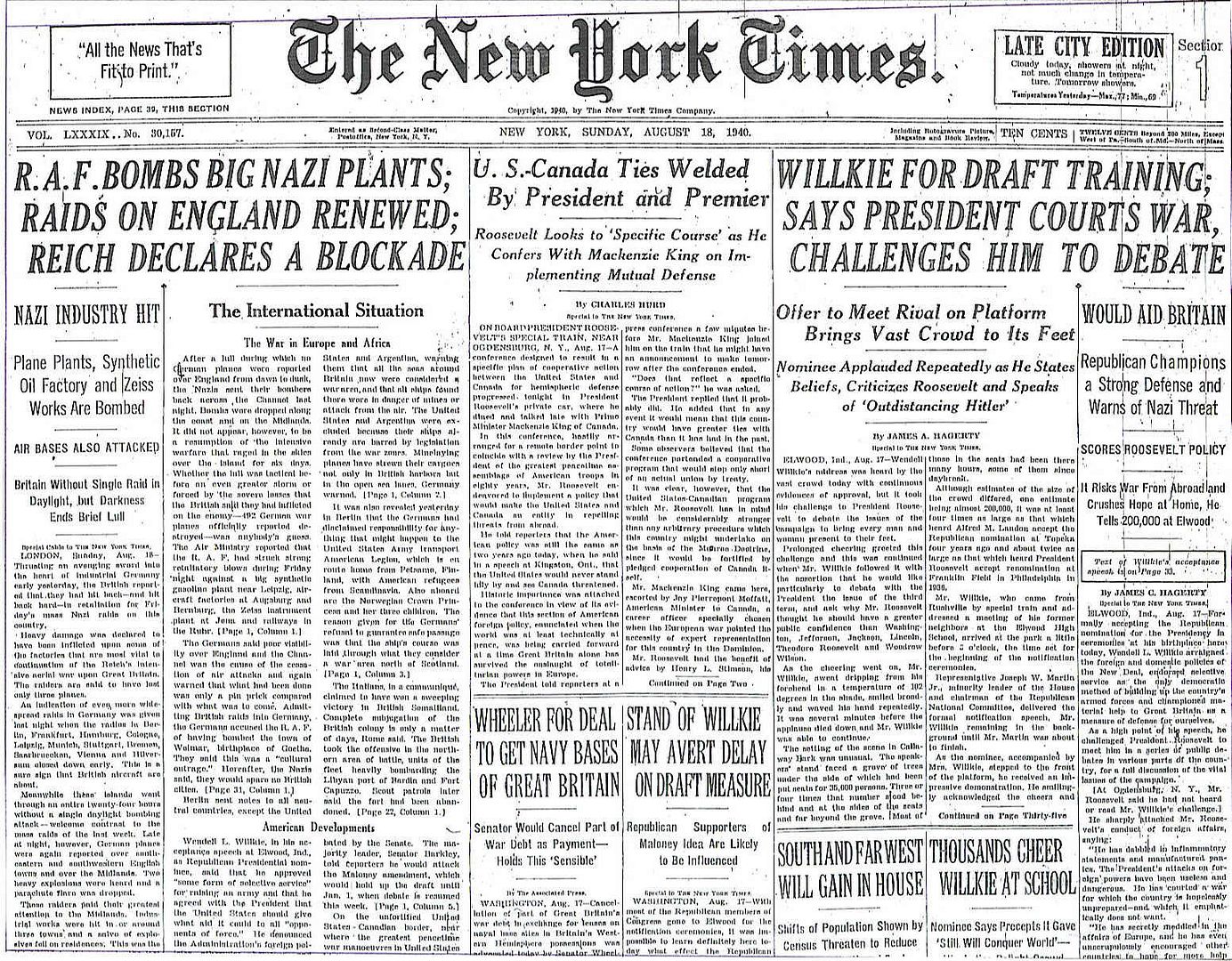
Posted on 08/18/2010 4:32:59 AM PDT by Homer_J_Simpson

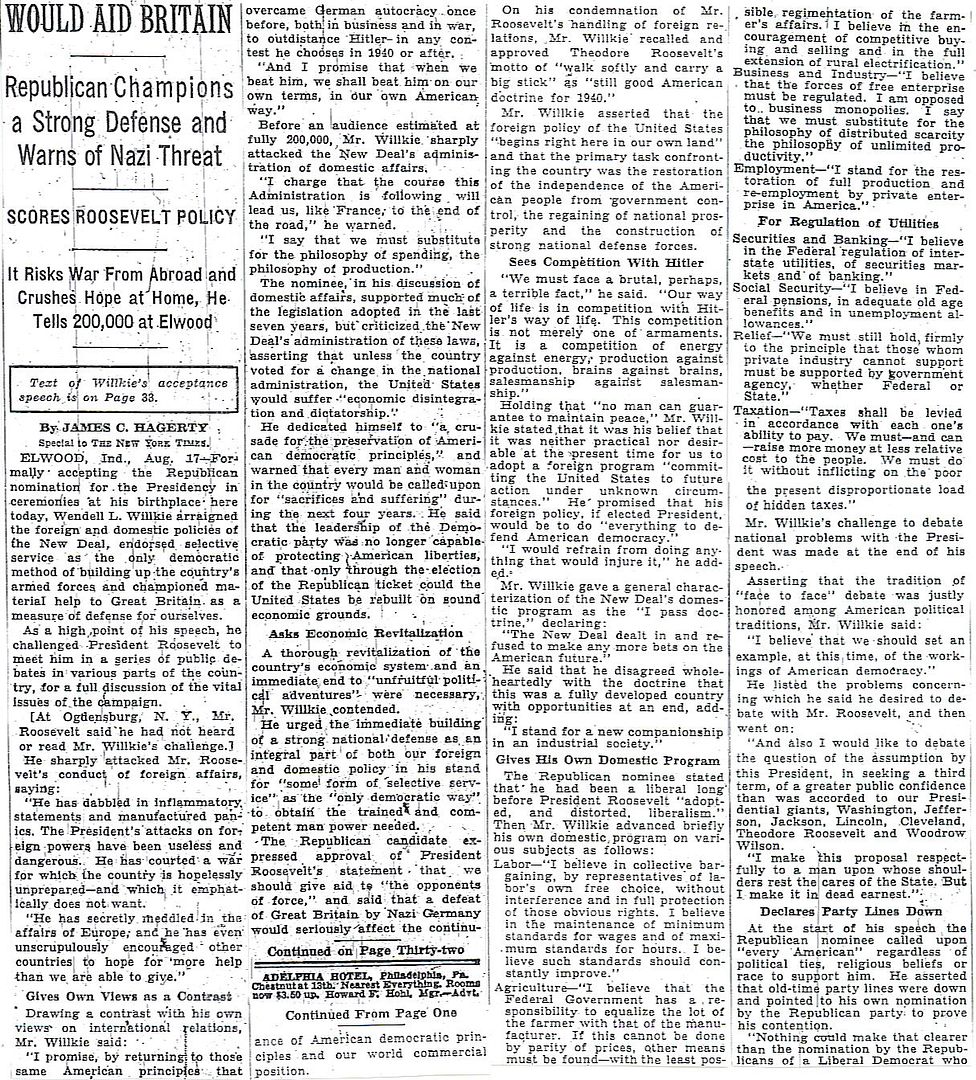
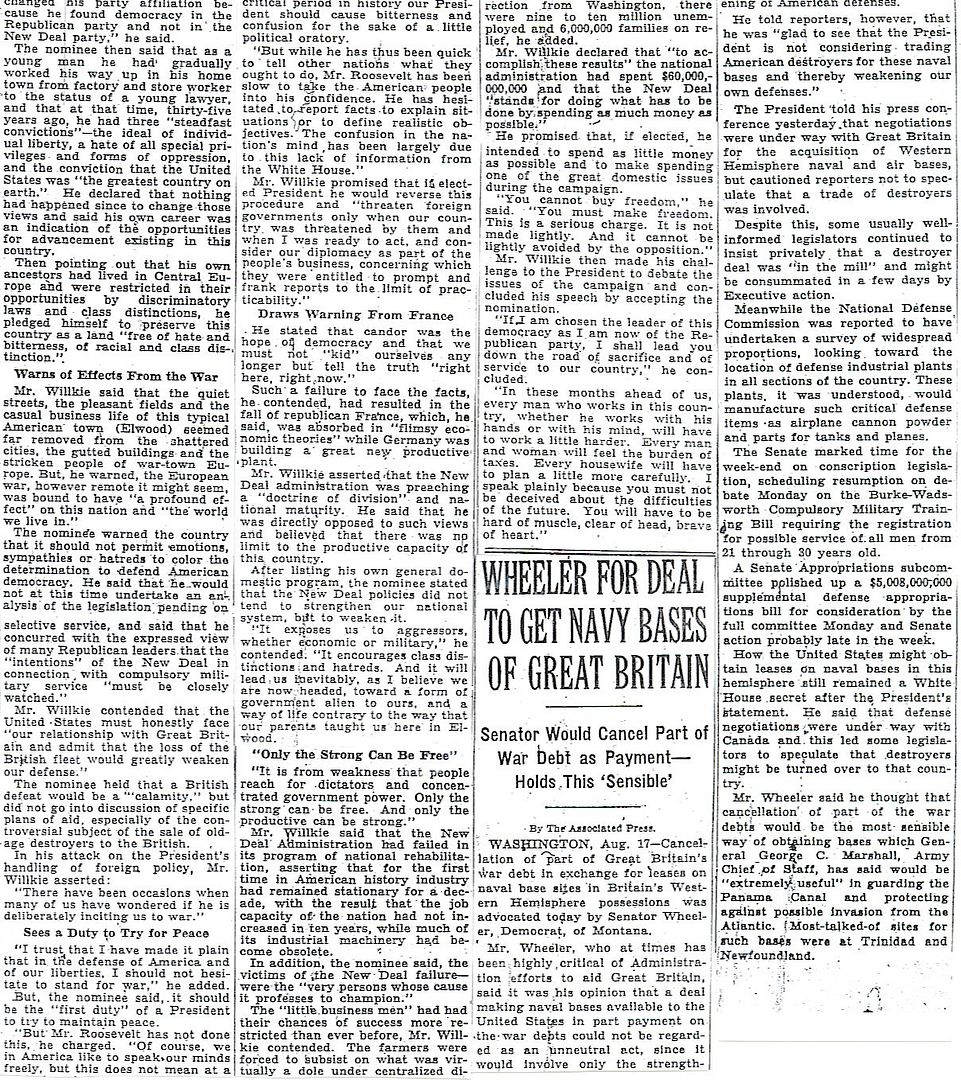
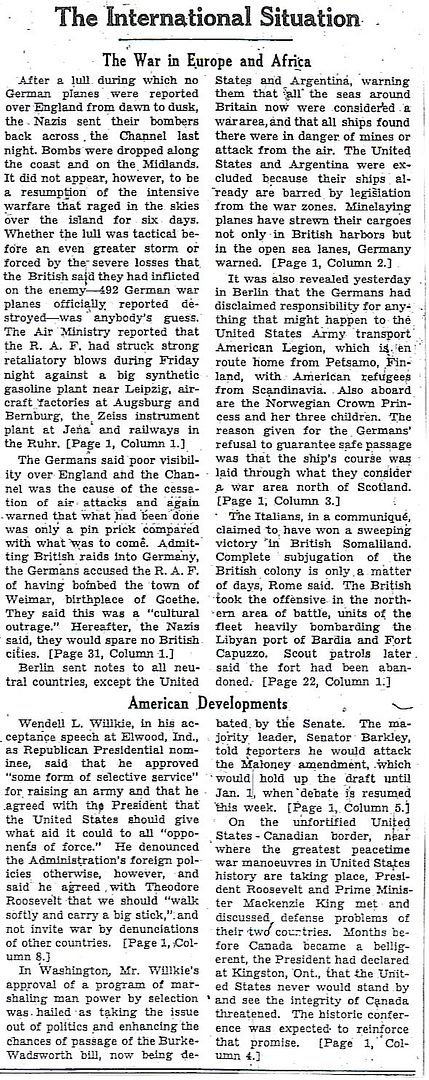
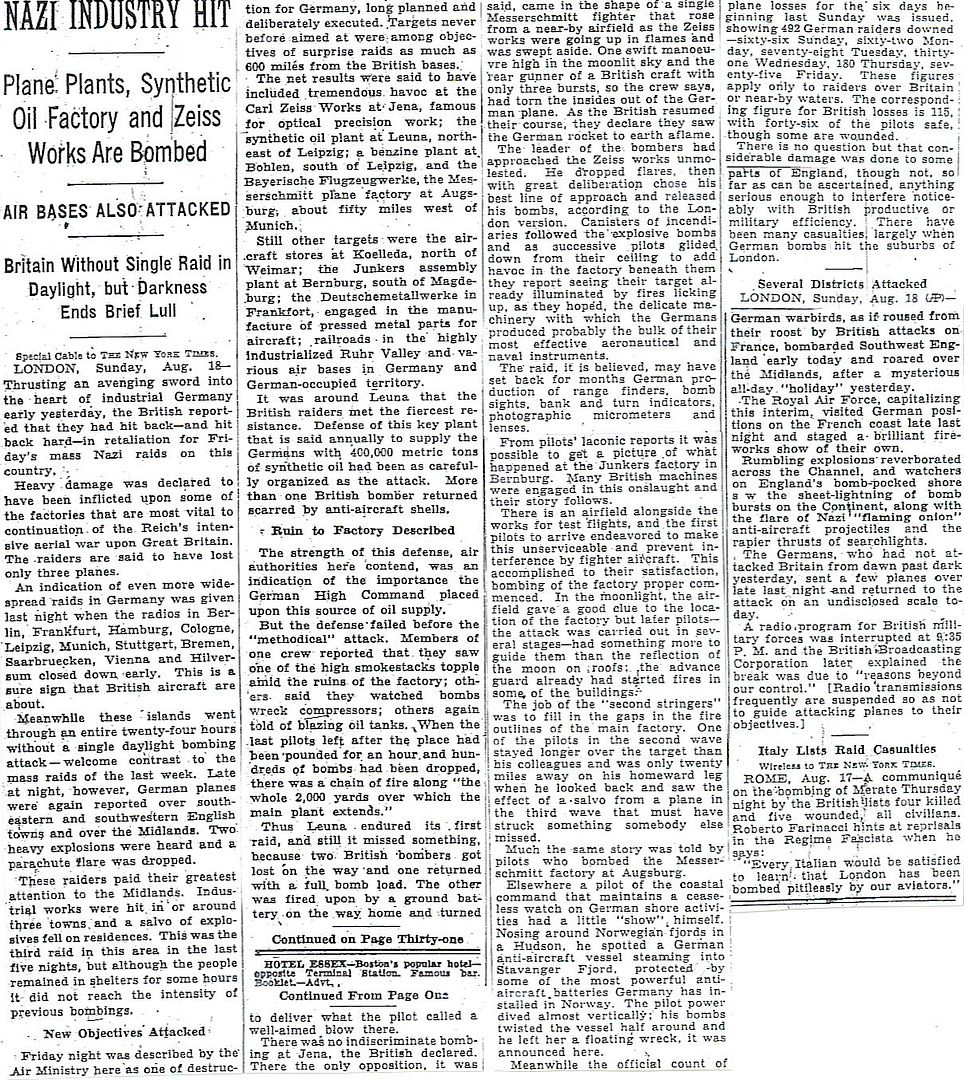
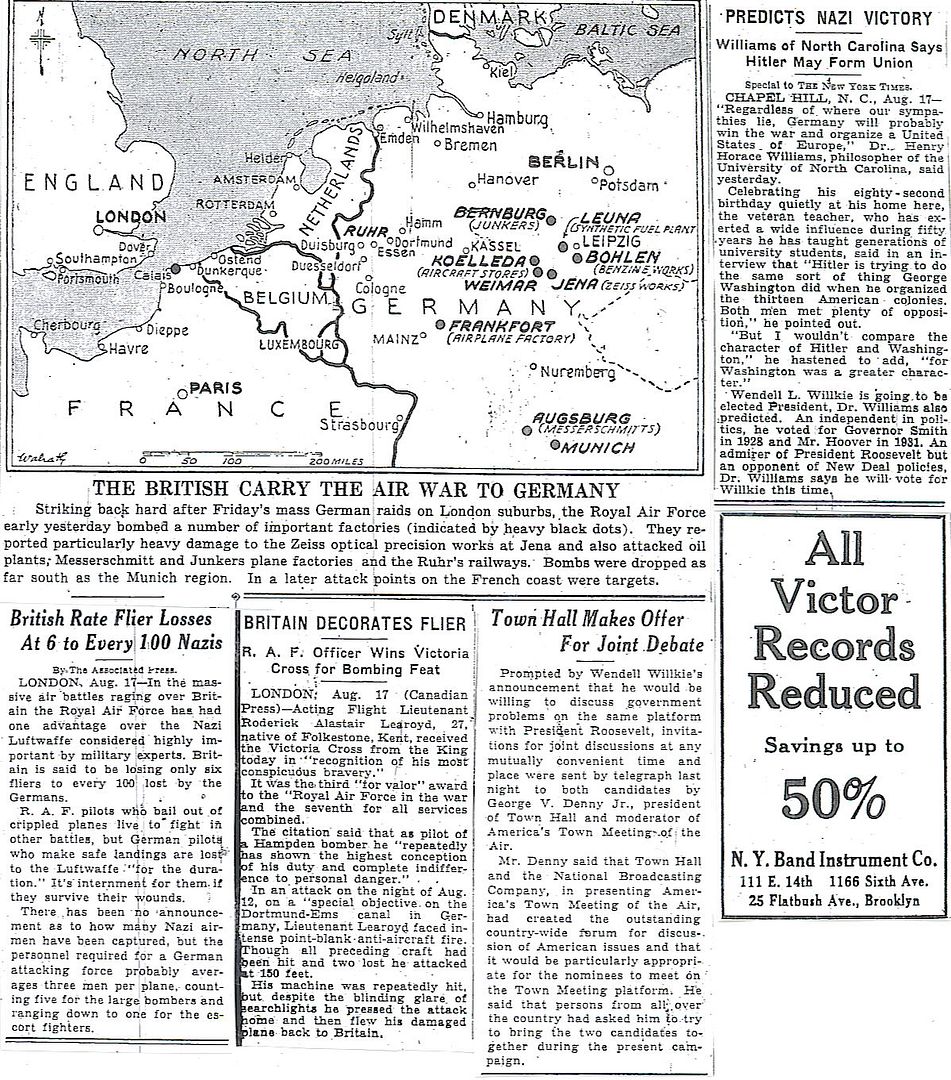
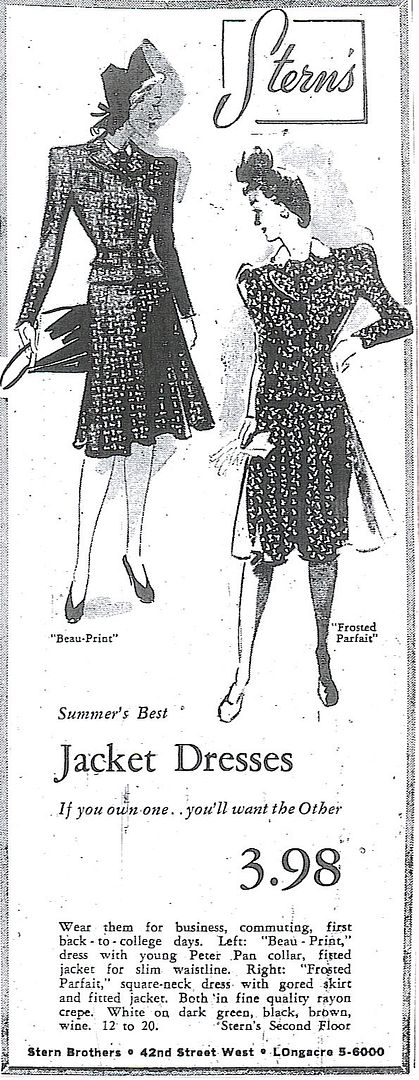
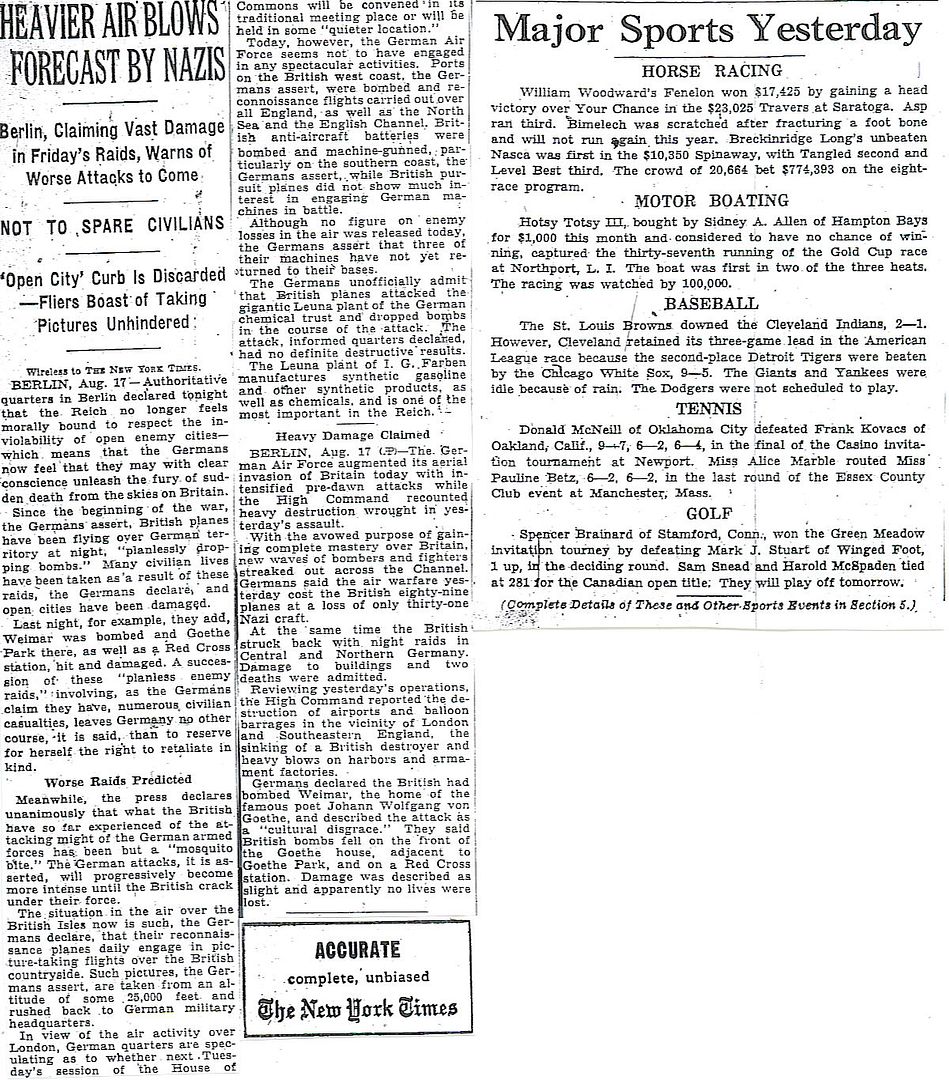
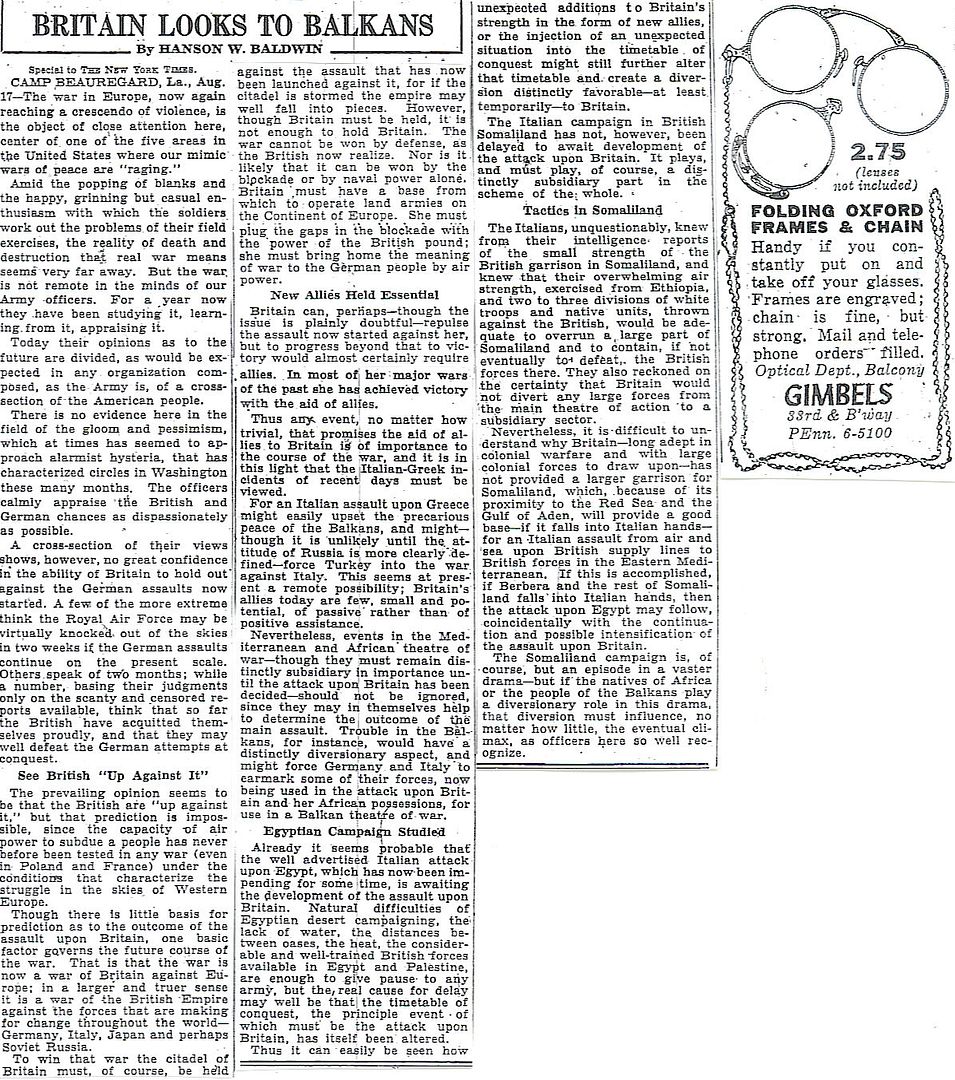
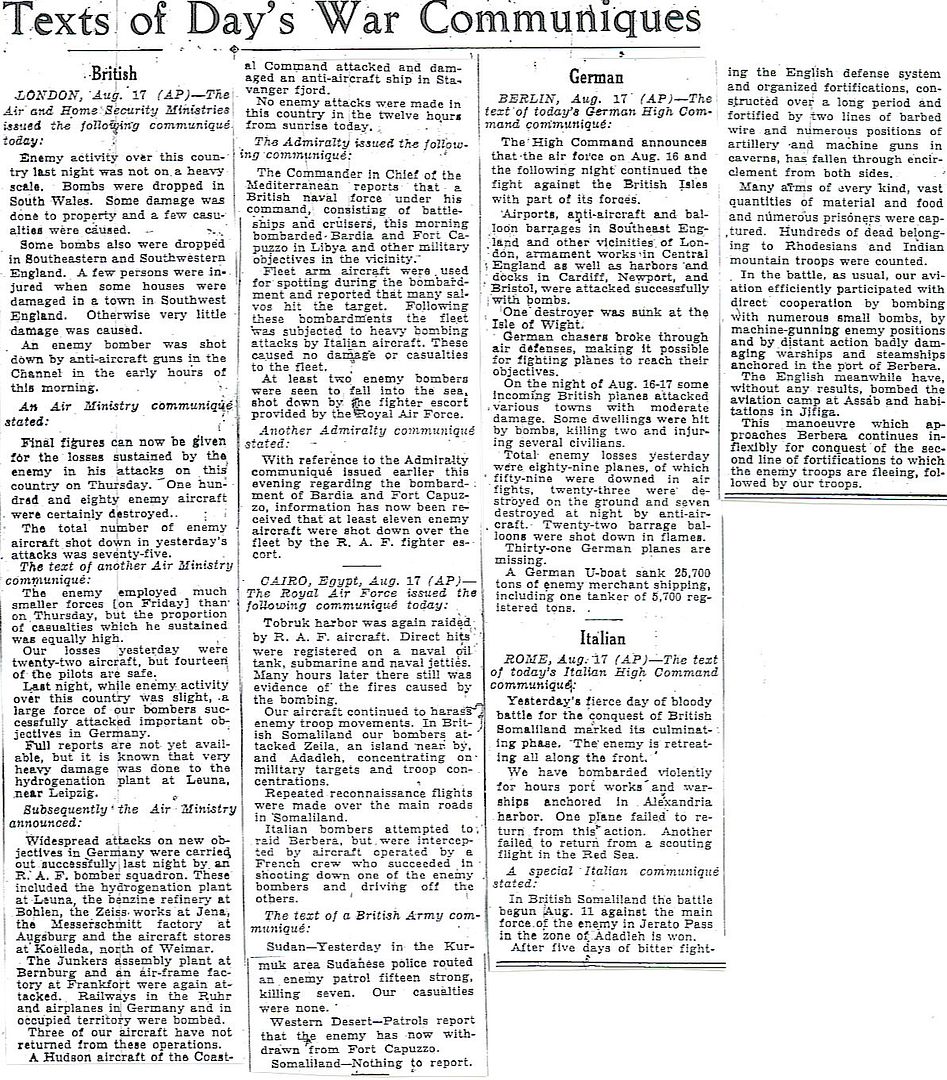
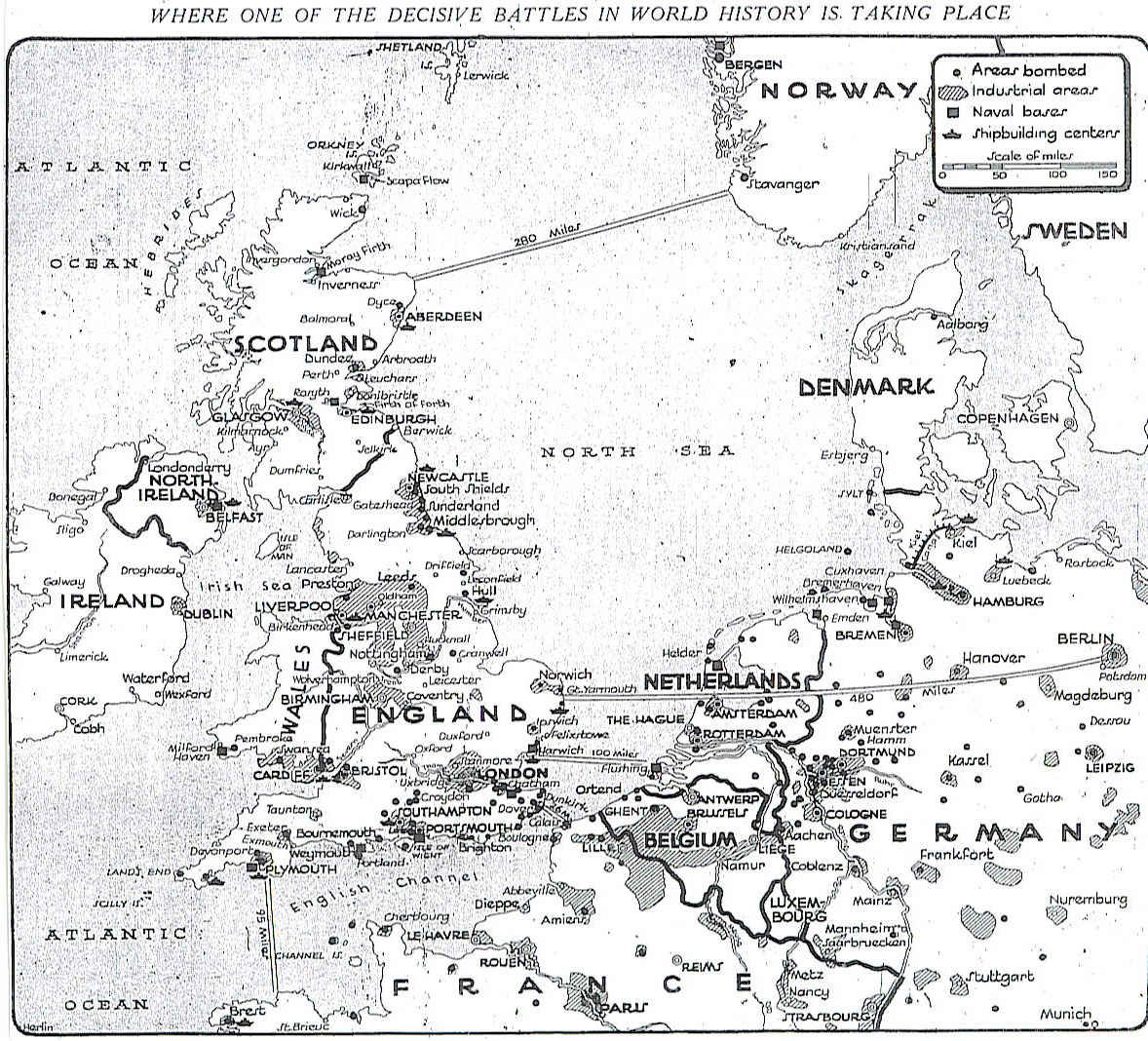
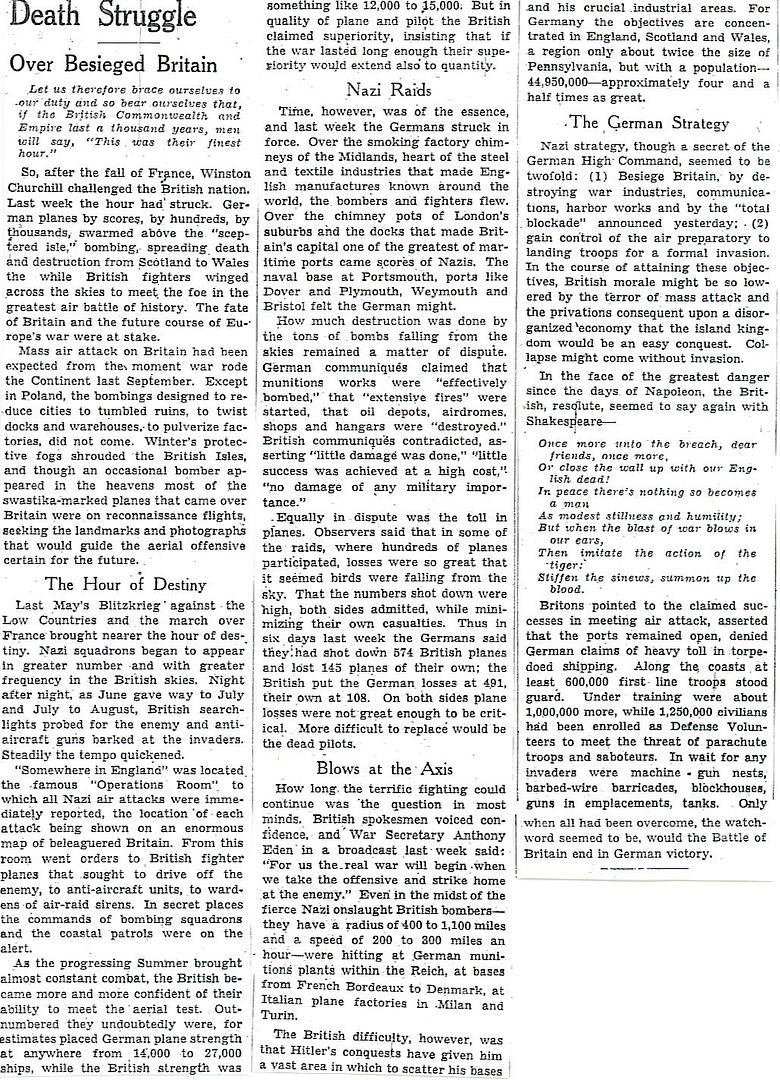
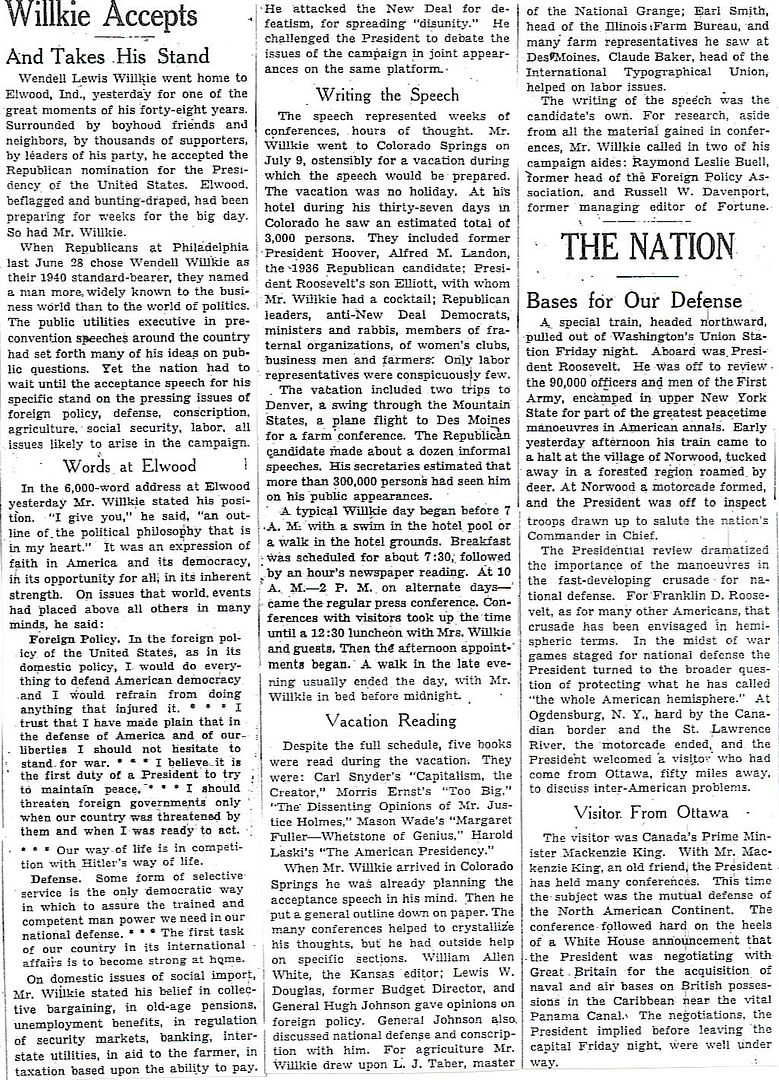
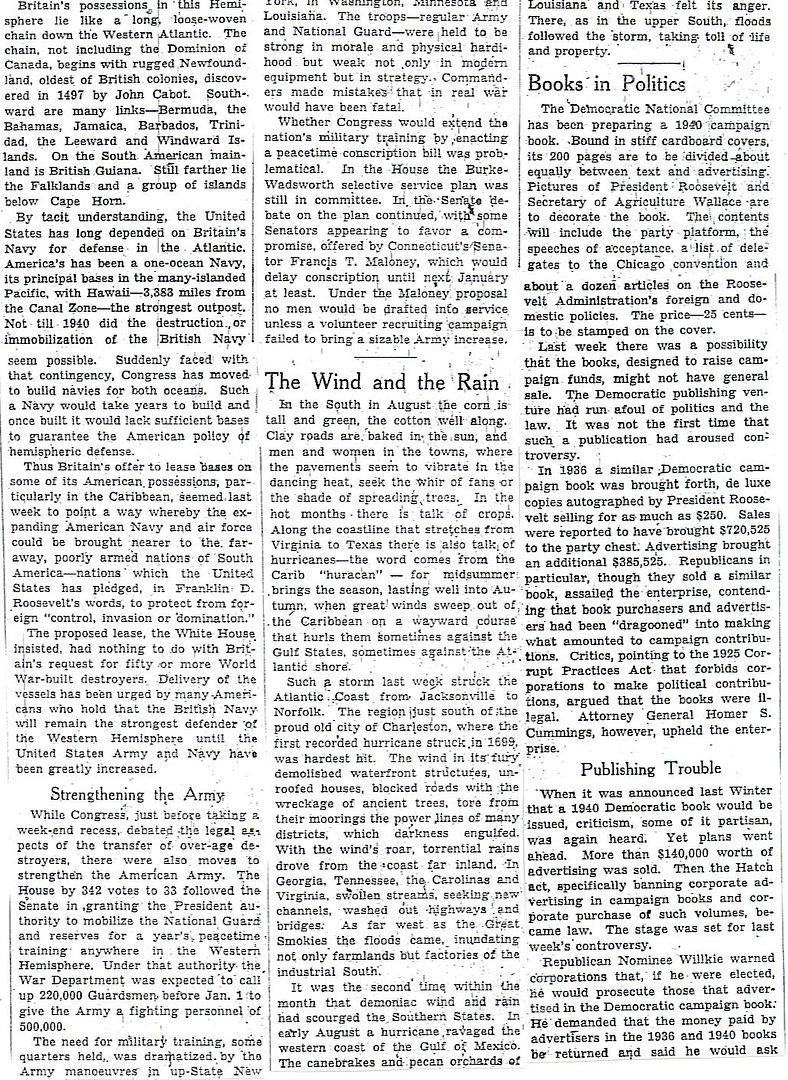
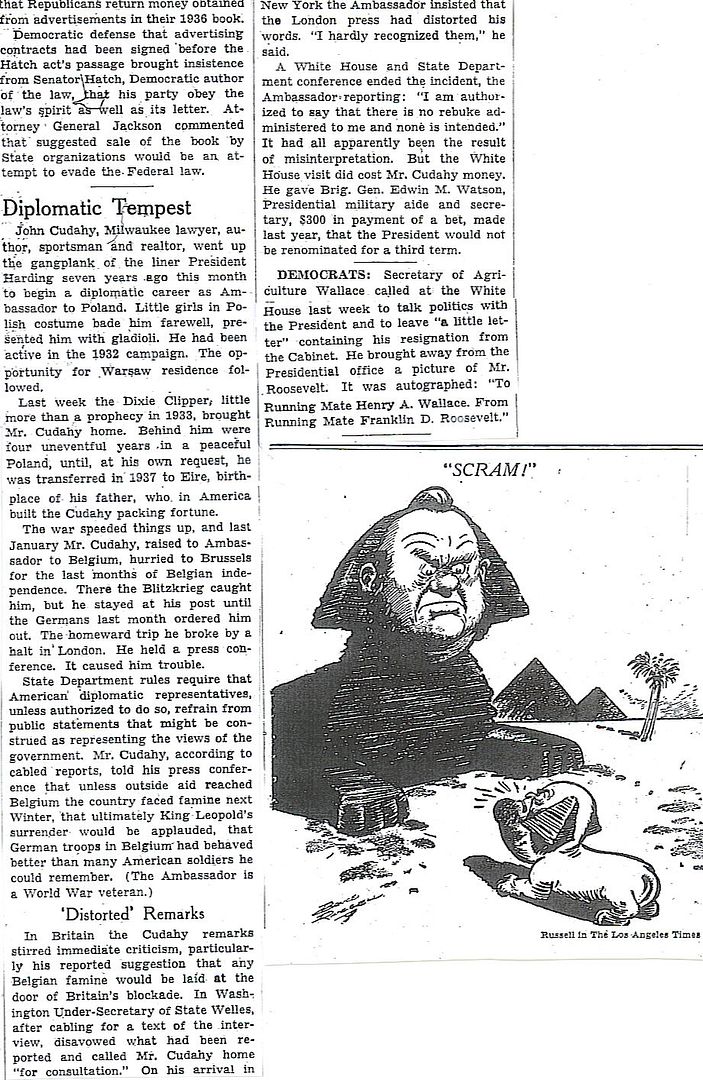
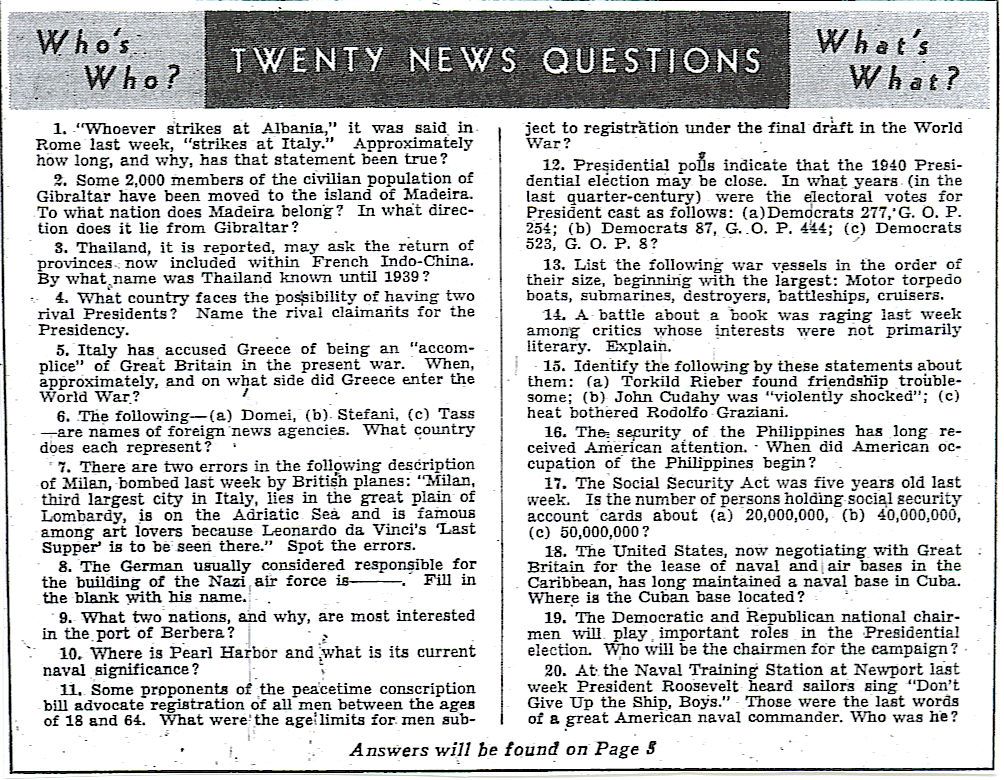
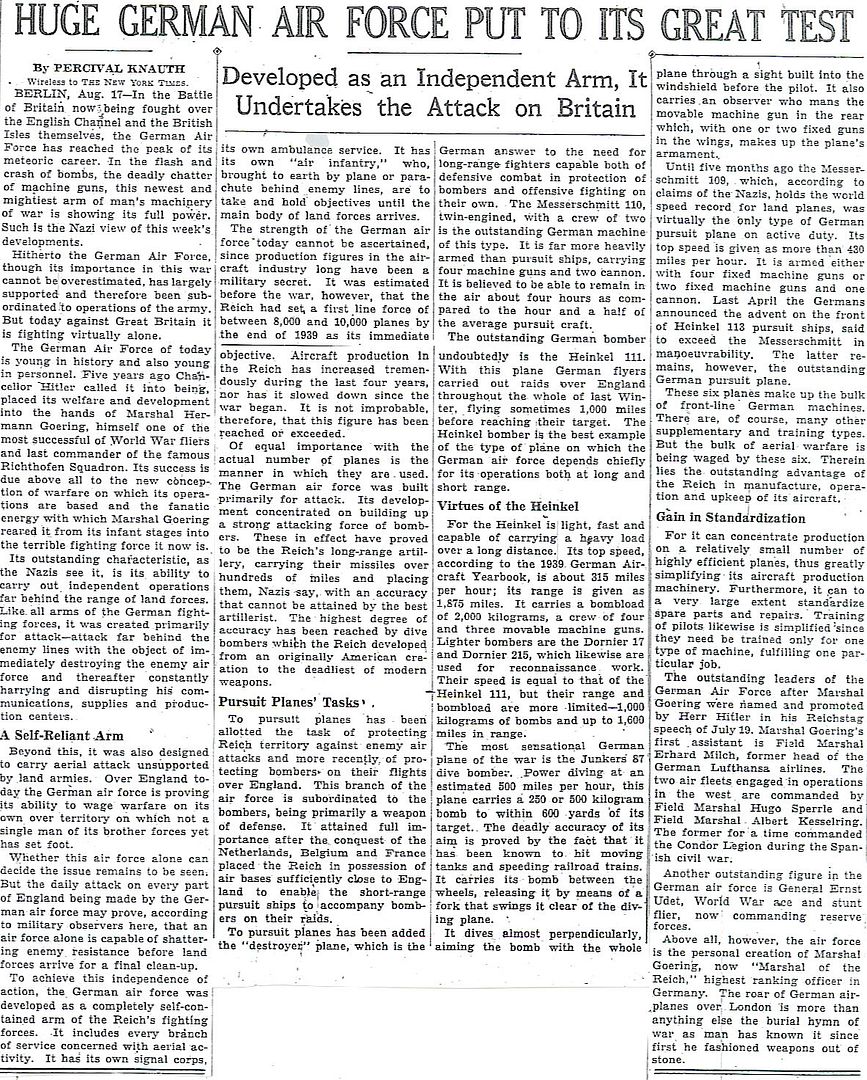
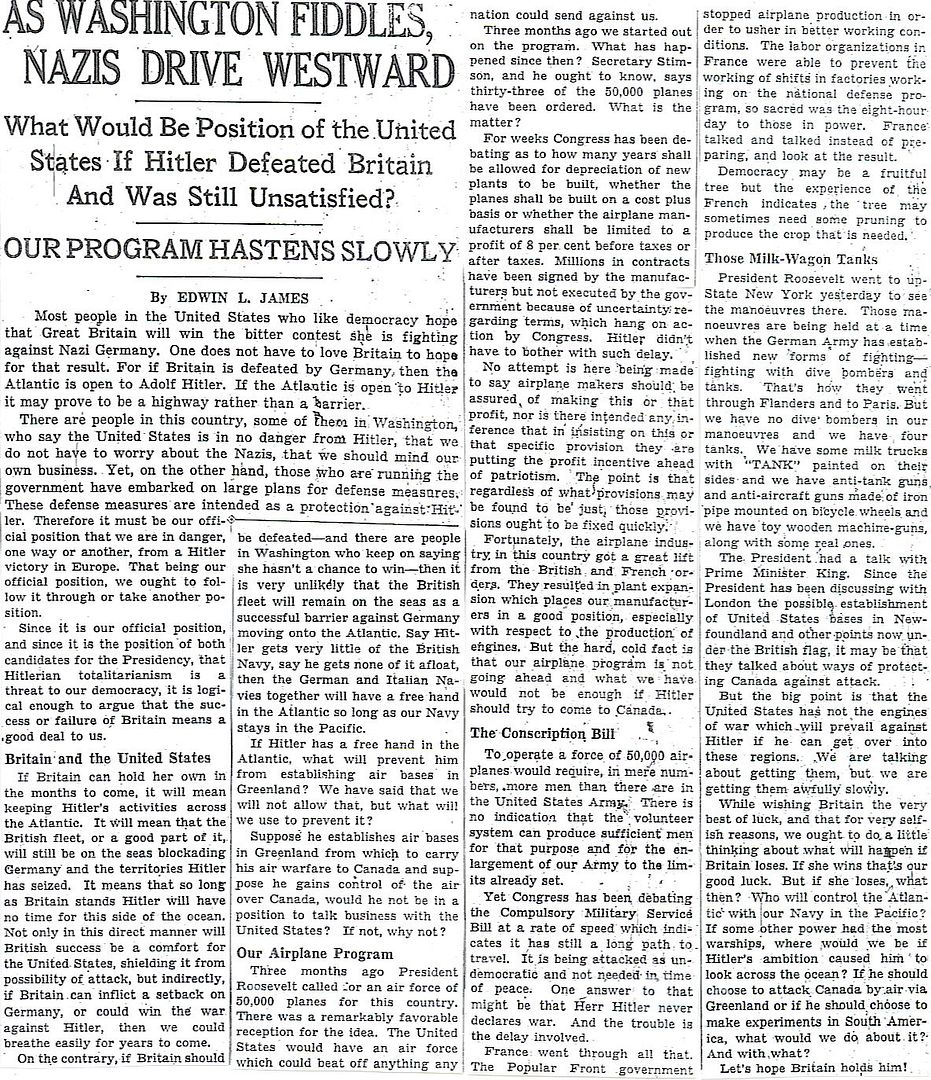
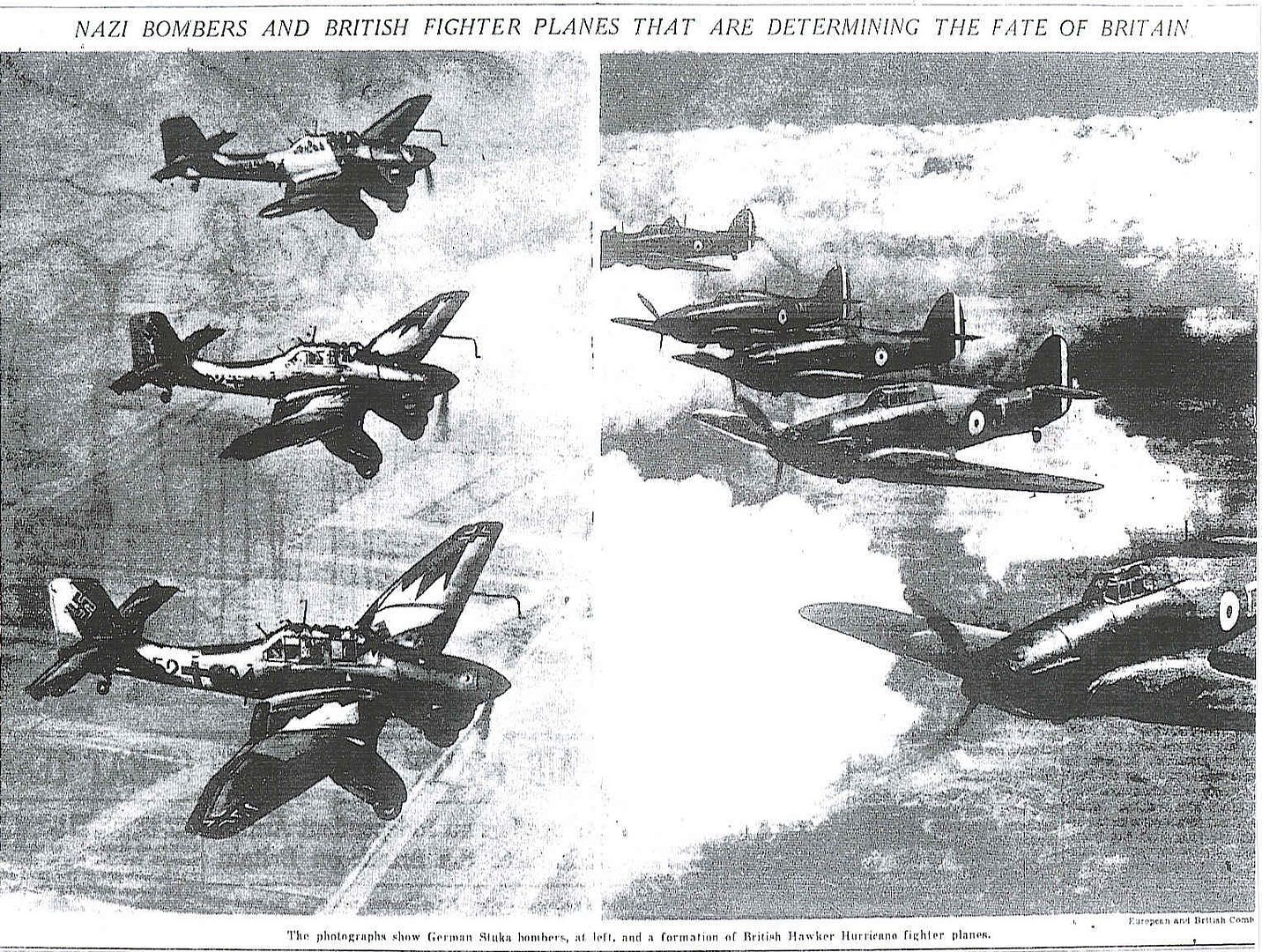
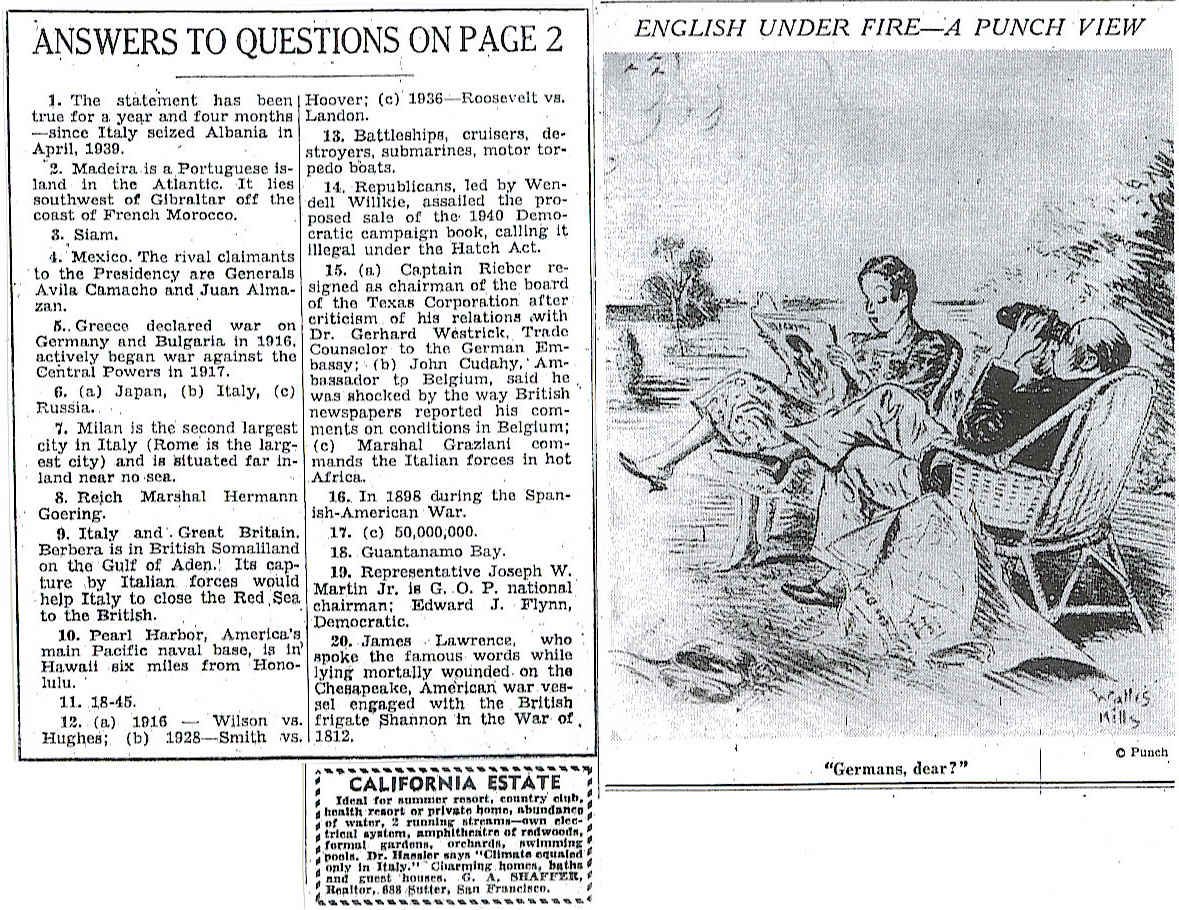
Plus a special guest map from Michael Korda’s, “With Wings Like Eagles,” showing the air defenses of England and Wales, August 1940.
“Neither Dowding nor anyone else could have guessed that the 18th would produce an air battle so intense and prolonged that at least one book has been written about this day alone (The Battle of Britain: The Hardest Day, by Alfred Price, Macdonalds and Jane’s Publishers, 1979).”
News of the Week in Review Where One of the Decisive Battles in World History is Taking Place (map) – 11
Death Struggle – 12-13
Willkie Accepts – 13
The Nation – 13-15
Twenty News Questions – 16
Huge German Air Force Put to Its Great Test – 17
As Washington Fiddles, Nazis Drive Westward – 18
Nazi Bombers and British Fighter Planes that are Determining the Fate of Britain (photo) – 19
Answers to Twenty News Question – 20
Thanks for posting these, Homer. They are extremely interesting.
http://www.onwar.com/chrono/1940/aug40/f18aug40.htm
Heavy German losses over airfields
Sunday, August 18, 1940 www.onwar.com
Over Britain... The Germans make another big effort. Their targets are still mostly airfields but not all the attacks are well organized. Biggin Hill escapes comparatively lightly, but Kenley is so disrupted that part of the fighter force has to be withdrawn to another airfield. The Germans lose very heavily, 71 aircraft to Fighter Command’s 27. The British originally claim that 155 have been shot down. Owing to heavy losses the Ju87 Stuka dive-bomber is withdrawn from attacks on targets inland.
http://homepage.ntlworld.com/andrew.etherington/month/thismonth/18.htm
August 18th, 1940
UNITED KINGDOM: Battle of Britain: Do17s of KG 76 bomb Kenley and Biggin Hill, only two aircraft from 9.Staffel returning unscathed.
RAF Fighter Command:
First Luftwaffe intruders of the day were six reconnaissance aircraft including a Bf110 of LG 2 which was shot down at 31,000 feet over Manston.
Come midday and an enormous force, 350-strong was assembling. 10 and 11 Groups’ squadrons were called to readiness. Three waves of raiders crossed the coast between North Foreland and Dungeness heading for targets south and south-east of London. They were first intercepted by 54 Squadron from its advanced base at Manston, soon joined by 70 fighters from nine other squadrons. One raid dropped 33 bombs on Deal.
Other raids attacked Biggin Hill ,Kenley and West Malling airfields. The West Malling gunners claimed two aircraft, but two hangars were hit and three Lysanders wrecked. Nine Do 17Zs of 9/KG 76 attacked Biggin Hill at low-level, strafing and bombing with mixed long and short-delay fused bombs, but 32 and 111 Squadrons shot down two, two crashed in the Channel and three force-landed in France, as the Dorniers left, three waves of Ju88s hit the stations landing ground. About 150 HE bombs were dropped with 60 hitting the airfield, the rest hitting the golf course. Some small anti-personnel bombs were also dropped on the gun sites, killing two men by a Bofors gun. Two of the Ju88s were destroyed, one by Flt. Lt. Stanford Tuck, forced by return fire to bale out of his 92 Squadron Spitfire.
Kenley was attacked shortly before West Malling. Nine Do17Zs of KG76 attacked the aerodrome from between 50 and 100 feet, followed Five minutes later the high level force arrived scoring hits on the Station Armoury, Sick Quarters and damaging six Hurricanes of 615 Squadron. Two of the low-flying element were brought down by Parachute and Cable rocket defences.. About 100 bombs were dropped. Twelve personnel died, 20 were injured. 615 Squadron responding to the raid was caught by the rear support Bf109s, and four aircraft shot down. One pilot was killed.
The afternoon phase began with six raids approaching east of the Isle of Wight just before 14:00. 70 Ju87s of StG77 accompanied by 24 Ju88s of KG54 attacked Poling CH radar station bringing down two pylons and disabling the station for a week, Ford naval air station was raided losing two hangars destroyed, a third of the quarters and killing 14, Gosport and finally Thorney Island where at 14:30 several Ju87s bombed a hangar and started a fire.
The Poling Stukas were intercepted by in turn 43, 152, 601 and 602 Squadrons with 234 Squadron taking on the top cover. In all 16 Ju 87s were shot down, two more crash landed and four were badly damaged, in addition to 8 escorting Bf109s shot down. The RAF lost four Spitfires and two Hurricanes.
At 15:30 a dozen Bf109s strafed Manston destroying two Spitfires, killing one man and injuring 15.
Two hours later 8 raids crossed over the Essex coast via the Blackwater and Thames estuaries. 54 and 151 Squadrons came into action to hinder the bombing of North Weald and Hornchurch.
During the night raids took place on South Wales, RAF Sealand (Chester), Birmingham and Wolverhampton. Another bomb at Hook, Hampshire, exploded killing five members of a bomb disposal squad dealing with it.
RAF Bomber Command: 4 Group (Whitley). Bombing - Caproni aircraft factory at Milan and Aluminium factory at Rheinfehlen.
10 Sqn. Ten aircraft to Rheinfehlen. Very bad weather, eight bombed primary.
58 Sqn. Ten aircraft to Rheinfehlen. Six bombed primary, one bombed an alternative target.
77 Sqn. Four aircraft to Milan. Four bombed primary, one claimed a fighter destroyed.
In the heaviest day of fighting so far, the Luftwaffe loses 69 planes to the RAF’s 33; another 29 RAF machines are wrecked on airfields.
L/Sgt William John Button (d. 1969), Royal Engineers, showed great coolness before and after a bomb on which he was working exploded, killing five sappers. (VC)
GERMANY: Berlin: Göring rebukes the Luftwaffe generals for their disappointing campaign, and the fighter ace, Adolf Galland asks for Spitfires in reply.
ETHIOPIA: Vickers Wellesley’s of the RAF bomb Addis Ababa from Perim Island.
NORTH AMERICA: Canada and the USA set up a joint defence board to co-ordinate military decisions. US President Franklin D Roosevelt and Canadian Prime Minister W.L. MacKenzie King sign the Ogdensburg Agreement which provides for a Permanent Joint Board for the defence of the US and Canada.(Jack McKillop)
U.S.A.: Walter P. Chrysler, the auto tycoon and founder of the Chrysler Corporation, dies at age 66. Chrysler had been president of the Buick Motor Company and resigned in 1919 to take control of the Maxwell Motor Company. In 1925, the company was renamed the Chrysler Corporation the manufacturer of Plymouth, Dodge, DeSoto and Chrysler automobiles.
In a display of utter bad taste and stupidity, Jimmy Powers, the sports editor of the New York Daily News newspaper, writes that the bad play of baseball’s New York Yankees can be attributed to “a mass polio epidemic” contracted from former Yankee first baseman Lou Gehrig. Gehrig, who is suffering from Amyotrophic Lateral Sclerosis (ALS) and quit the game in 1939, and his former roommate, catcher Bill Dickey, sue the Daily News and the newspaper retracts the story on 26 September and apologizes. (Jack McKillop)
Light cruiser USS Columbia laid down. (Dave Shirlaw)
http://worldwar2daybyday.blogspot.com/
Day 353 August 18, 1940
Battle of Britain Day 40. Haze in the morning gives way to good flying weather. At noon, Germans launch staged attacks against key RAF Fighter Command airfields at Kenley and Biggin Hill. However, the plan is too complicated and Luftwaffe formations do not arrive over the target on schedule. Kenley is subjected to devastating bombing, but Hurricanes of 111 Squadron wreak havoc on the bombers which have got ahead of their escorts. Hurricanes of 32 and Spitfires of 610 Squadron break up the attack on Biggin Hill and most bombs miss their target. RAF loses 22 fighters but claims 140 German planes shot down (although this seems unlikely). http://www.battleofbritain1940.net/0028.html
British Somaliland, East Africa. Overnight, troopships Chakdina, Chantala, Laomedon & Akbar and hospital ship Vita leave Berbera carrying British troops across the Gulf of Aden to Aden. In total 7,000 people, including civilians are evacuated. Australian cruiser HMAS Hobart remains to collect stragglers and destroy vehicles, fuel and stores. Somalis of the Somaliland Camel Corps choose to remain instead of evacuating and are allowed to keep their weapons.
I didn’t do too well on the news quiz—I missed five, earning a “C.”
It’s interesting that both Pearl Harbor and Guantánamo were in the news quiz. Some time in the future, both names may become household words.
That's a tough quiz this week. I had to peek at the answers to get 5.
Date: 18th August 1940

Enemy action by day
Enemy activity resumed an extensive scale after the lull of the previous day.
Two main attacks developed in the South-East at about 1230 and 1700 hours. In the former case, the attacks spread over the South-Eastern Home Counties and in the latter case over Essex and Kent. London Central received 'Red' warnings in each instance.
Another big attack was directed on the Portsmouth-Southampton area at 1400 hours. Interceptions were effected by fighters and 126 enemy aircraft shot down.
East Coast
One raid was plotted off Great Yarmouth and at 1700 hours crossed the coast, flew inland across England to Birmingham, Worcester and Cardiff and then south Weymouth.
South and East Coasts
Between 0908 and 0935 hours, three reconnaissances were made over Dover and The Straits. Three further reconnaissances were made between 1042 and 1102 hours at about 20,000 feet to 25,000 feet up the Thames Estuary.
At 1230 hours, a heavy attack was launched between North Foreland and Dungeness and comprised some 300 enemy aircraft. It penetrated as far as South and South-East London, returning to the Calais area in scattered groups. The enemy aircraft came in three waves; the third, however, appeared to turn back near the coast. Kenley, Croydon, Biggin Hill, Manston and West Malling were attacked.
At 1430 hours, a secondary attack consisting of about 50 aircraft was directed towards Dover, but only about 12+ crossed the coast and these are reported to have attacked Dover balloons.
At 1700 hours, eight raids numbering 200 aircraft approached the coast between Harwich and Dungeness. The majority flew up Black Water and the Thames towards Rochester, Hornchurch and North Weald. The raids broke up on being intercepted and were forced out to sea by 1810 hours. The aircraft taking part in this raid assembled near St Omer and are thought to have come from Antwerp.
South and West Coasts
At 1415 hours, six raids approached the Portsmouth area and were estimated to number 150 aircraft. RAF establishments were attacked at Thorney Island, Gosport, Ford and Poling. The enemy aircraft dispersed at about 1500 hours.
By night
There was only slight enemy activity.
At 2200 hours, a single enemy aircraft approached the Thames Estuary and is reported to have dropped bombs near Dunkirk RAF Station. Between 2200 and 0100 hours, a number of small raids appeared off the East Anglian Coast and three or four raids in the Thames Estuary. Minelaying was suspected in both areas. Between 2300 and 2330 hours, three single aircraft raids penetrated inland to the Digby-Grantham area. Between 2100 and 0200 hours, about 14 raids were plotted in the South Wales and Bristol areas. A few of these penetrated as far north as Shrewsbury and Liverpool. At about 0225 hours, a single aircraft made landfall near Skegness.

________________________________________
Statistics
Fighter Command Serviceable Aircraft as at 0900 hours, 18th August 1940
Casualties:
| Enemy Losses | ||
|---|---|---|
| By Fighters | ||
| Destroyed | Probable | Damaged |
| 34 Me109 | 4 Me109 | 13 Me109 |
| 26 Me110 | 9 Me110 | 8 Me110 |
| 11 Do215 | 5 Do215 | 1 He113 |
| 6 Do17 | 3 Do17 | 4 Do215 |
| 31 Ju87 | 2 Ju87 | 9 Do17 |
| 7 Ju88 | 1 Ju88 | 2 Ju87 |
| 8 He111 | 2 He111 | 1 Ju88 |
| 3 unknown | 4 He111 | |
| 3 unknown | ||
| 126 | 26 | 45 |
| By Anti-Aircraft | ||
| Destroyed | Probable | Damaged |
| 13 unknown | ||
| 13 |
Patrols:
Balloons:
Aerodromes:
Organisation:
Air Intelligence Reports
Home Security Reports
Books in Politics
.....”When it was announced last Winter that a 1940 Democratic book would be issued, criticism, some of it partisan, was again heard. Yet plans went ahead. More that $140,000 worth of advertising was sold. Then the Hatch Act, specifically banning corporate advertising in campaign books and corporate purchase of such volumes, became law. The sate was set for last week’s controversy.
Republican Nominee Willkie warned corporations that, if he were elected, he would prosecute those that advertised in the Democratic campaign book; He demanded that the money paid by advertisers in the 1936 and 1940 books be returned and said he would ask that Republicans return money obtained from advertisements in their 1936 book.
Democratic defense that advertising contracts had been signed before the Hatch act’s passage brought insistence from Senator Hatch, Democratic author of the law, that his party obey the law’s spirit as well as its letter. Attorney General Jackson commented that suggest sale of the book by State organization would be an attempt to evade the Federal law.
Disclaimer: Opinions posted on Free Republic are those of the individual posters and do not necessarily represent the opinion of Free Republic or its management. All materials posted herein are protected by copyright law and the exemption for fair use of copyrighted works.